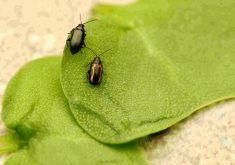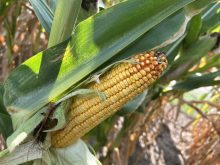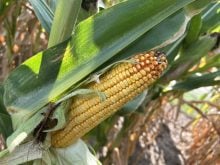They’ll survive what would kill other crop pests.
Some species will eat each other. If food is scarce, they might reverse molt to become smaller and harder to starve. They’ll go after grain crops, potatoes, onions, carrots, strawberries or almost any other field crop. Their tendency to feast on germinating seeds and young shoots under the soil can be mistaken for other issues that cause poor emergence.
Once in a field, the farmer might fight them for over a decade. Foliar insecticides don’t work.
Read Also

Manitoba boosts stake in cereals centre to $23.5 million
Premier Wab Kinew said the additional project funds will help ‘Trump-proof’ the provincial economy.
Welcome to the problem of wireworms.
Why it matters: Wireworms are resilient and adaptable, and neonicotinoid seed treatments provide only limited protection.
Wireworms are larvae of the family of insects known as click beetles, named for the sound they make when placed on their backs.
“We’ve basically got about 100 species of click beetles in Manitoba, but there’s really just a couple of them that are pest wireworms here in the Prairies,” Manitoba Agriculture entomologist John Gavloski said during a May 8 webinar on the pest.
Manitoba has a relative advantage when it comes to wireworms. Local types are less aggressive compared to those in Saskatchewan, British Columbia and Atlantic Canada.
The most common species in this province is a small, pale-yellow worm called Hypnoidus bicolour (lined click beetle), which spends two to three years in the soil before developing into an adult. Producers to the west, particularly in Saskatchewan, face the larger, orange-hued prairie grain wireworm, which consumes more feed per worm and can live from four to 11 years in the soil.
“The 11 years would only be if they didn’t have a lot of food,” Gavloski said. “If they have good food, in four or five years they turn into an adult.”
[RELATED] Farmtario: Cimegra label expansion to help control potato beetles
A third species, Aelosus mellillus (flat wireworm), may also be a problem. That type feeds at the soil surface and cuts stems off rather than boring in and shredding them, Manitoba Agriculture’s website states.
A lineup of western Canadian pests, published by Agriculture and Agri-Food Canada in 2019, also notes western wireworm, wheat wireworm and dusky wireworm as pest species.
Not all wireworms limit themselves to plants. One survey out of Prince Edward Island illustrated predatory behaviour, Gavloski noted. That included the problematic prairie grain wireworm.
“The prairie grain wireworm is an opportunistic predator. If it does come across insect larvae or even other wireworms, it will eat them. It’s been known to cannibalize other prairie grain wireworms that are smaller than them.”
Few tools
Wireworm habits make them hard to control. The feeding damage happens at the larval stage, when they live completely underground, out of reach of sprayed pesticides.
Farmers instead must rely on seed treatments. Neonicotinoid treatments containing thiamethoxam, imidacloprid or clothianidin offer some protection, but they are more of a deterrent than true control.
“They don’t feed well when the plants are getting established (with those treatments), but the wireworms don’t necessarily die off in big numbers,” Gavloski said.
Because neonics don’t reduce populations, wireworms could develop resistance if those products are overused.
Farmers got a different tool in 2021, when BASF’s group 30 broflanilide-based products hit the Canadian market. Terraxa 4 is a fungicide-insecticide combo for cereals, while Cimegra is tagged for in-furrow wireworm control in potatoes, as well as foliar use against Colorado potato beetle.
Those products target the nervous system of wireworms and kill them.
Scientists are also working with a fungus called Metarhizium anispoliae, which can kill wireworms and could be a future microbial insecticide.
Scouting
Producers should dig into bare patches they might otherwise ascribe to poor germination to see if they have a problem, Gavloski advised.
In other infestations, the crop will come up, but stems will appear shredded from wireworm feeding underground. In cereals, a plant’s centre leaves may be yellowed or wilted. Hollowed out seeds are another sign.
Overly hot or dry soil will send the worms deeper.
“The soil is moist this time of year and they’re probably close to the soil surface, but as the soil heats up and dries out a bit later in summer, they do move much deeper and get much trickier to find,” said Gavloski.
In late summer, they will return close to the soil surface.
Producers should also be careful with identification. Wireworms can be mistaken for cutworms or for stiletto fly larvae, the latter of which is farmers’ friend.
“Stiletto fly larvae are actually predators of other insects in the soil, such as wireworms,” Gavloski said. “So, if it’s pale white and not yellowish or orange, it could be a stiletto fly larva. Those are the good guys.”
Some producers try to bait wireworms out of the soil with potatoes, oats or presoaked corn and wheat mixtures. Manitoba Agriculture recommends baits be buried 7.5-10 centimetres deep and checked a week to 10 days later.
Baiting isn’t a guarantee that wireworms will show themselves, Gavloski said.
“The way wireworms find their food is they follow carbon dioxide trails in the soil. Early in the season, when there’s not a lot of carbon dioxide sources, you will get them coming for your potatoes or bait balls.
“But once you’ve had a lot of stuff in the field with roots, it competes with big traps.”
Manitoba Agriculture recommends seeding into warm, moist soil to encourage crops to germinate quickly and develop beyond the most vulnerable growth stages.
















